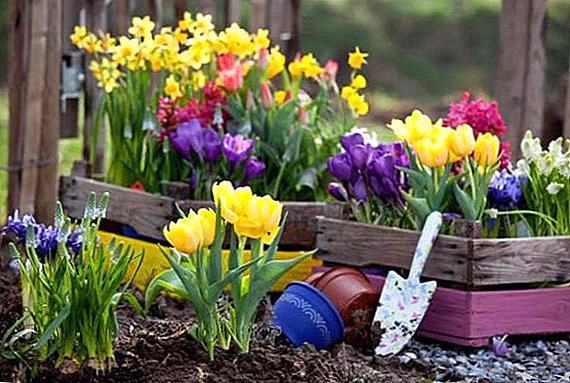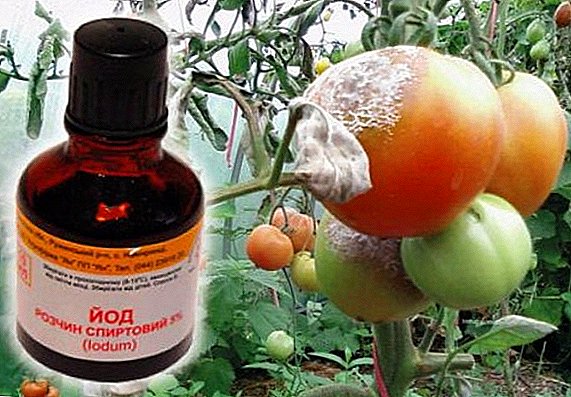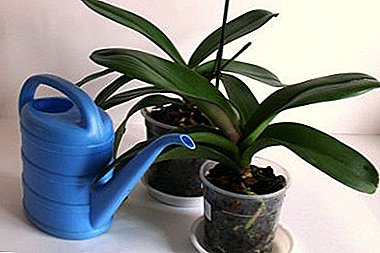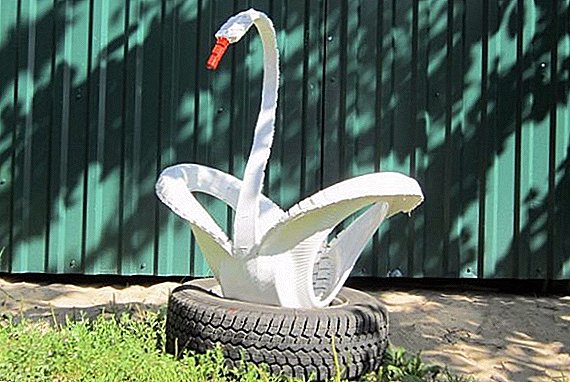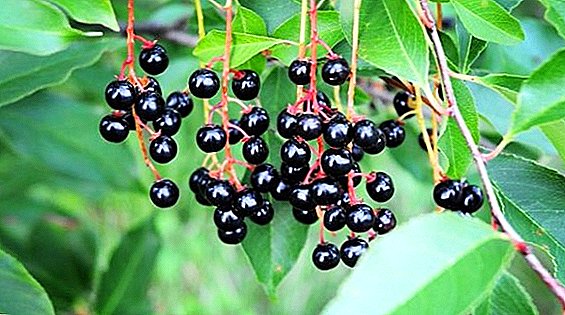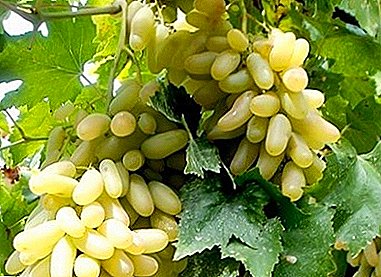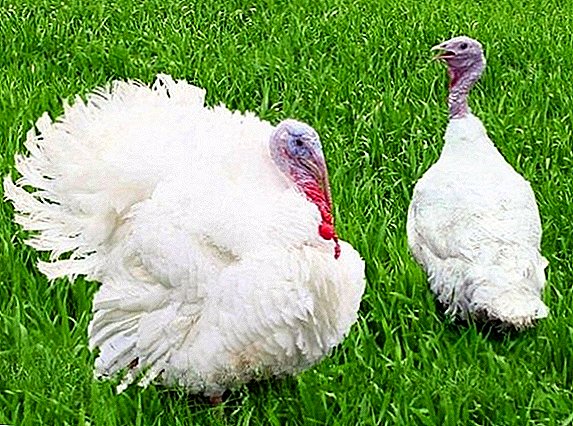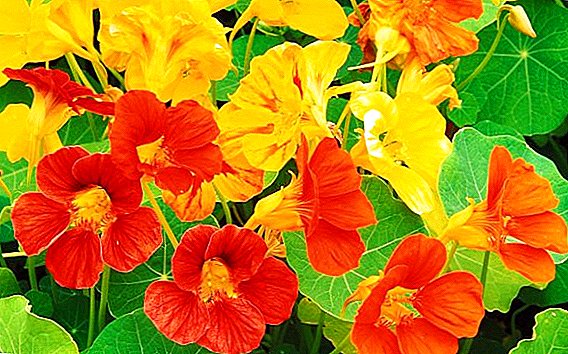 Nasturtium - a herb with bright colors. Nasturtium homeland - South and Central America. In nature, more than one hundred species and varieties of this plant are known.
Nasturtium - a herb with bright colors. Nasturtium homeland - South and Central America. In nature, more than one hundred species and varieties of this plant are known.
Varieties and varieties of nasturtium
The following types are most popular with gardeners: Canary Nasturtium looks like a vine, has stems up to four meters in length. The plant blooms in June and blooms until December. Its flowers are bright yellow in color, resembling a bird.
Big nasturtium - It is a shrub with large leaves in the form of a shield, with long stems growing to three meters. It blooms from mid-summer to November.
Small nasturtium. The name speaks for itself - the diameter of flowers is no more than 3 cm, the stems grow to 35 cm.
Shchitonosny view. Shoots of this species grow to 4 m. This nasturtium blooms in June with purple-red flowers.
Cultural Nasturtium obtained by crossing large and shield-bearing, sometimes creeping and dwarf.
The most unusual varieties in color and brightness:
 "Vesuvius" - shrub variety, bright coral flowers, sometimes the color turns to orange, with bright red splashes on the petals.
"Vesuvius" - shrub variety, bright coral flowers, sometimes the color turns to orange, with bright red splashes on the petals.
"Day and night" - low shrub. The flowers are cream and red, especially look beautiful against the background of lush green foliage.
"Cherry Rose". Terry flowers, painted in a bright pink color, turning into a crimson hue.
"Terry mix". Flowers terry, have all shades of yellow and red and delicate delicate aroma. Shrub grows up to half a meter tall.
"Alaska". The foliage of this nasturtium marble color is white-green. The color of the petals is yellow, orange and red.
"Yeti". Shoots of this nasturtium grow up to two meters in length. The flowers are creamy white with yellow splashes in the center of the petal.
Did you know? In America of the pre-Columbian period, the tribes of the Indians of Peru and Chile used and raised nasturtium for food. These were the types of perennial tuber-bearing and thin-leaf nasturtium.
Cultivation and care
 In our climate, nasturtium is grown as an annual plant. Do not rush to sow the seeds of nasturtium, as soon as spring came. Spring frosts are not uncommon in our climate, and seedlings of a heat-loving plant will not survive them. It is best to plant nasturtium seedlings in April.
In our climate, nasturtium is grown as an annual plant. Do not rush to sow the seeds of nasturtium, as soon as spring came. Spring frosts are not uncommon in our climate, and seedlings of a heat-loving plant will not survive them. It is best to plant nasturtium seedlings in April.
The choice of a place for landing nasturtium and illumination area
Nasturtium loves light, heat and does not tolerate temperature extremes. Therefore, choose a plot under the sun or light penumbra, with shelter from drafts - this will be the place where it is better to plant a nasturtium in the country. For a climbing vine there is a need for support, for which it will cling, for example, a fence, a fence, a wall of an arbor.
Preparing the soil for planting
For nasturtium, the presence in the ground of an excess of organic fertilizers, especially fresh manure, is undesirable. On the poor, non-cultivated soils of nasturtium flowering, we can not wait, even the leaf cover will be plain and rare. Heavy clay soil is also not suitable. Nasturtium has a superficial root system, so the best option for it is light, slightly acidic soil with good drainage. To improve the granulometric characteristics of the soil, add sand to it.
Top dressing, watering and weeding
 Watering and feeding nasturtiums do not have any particularly complex recipes. For feeding plants are best suited feed with potassium and phosphorus. Ideal - superphosphate, diluted in water. Although this fertilizer is difficult to dilute, but in this form the nasturtium takes it better. Fertilizers containing a small amount of nitrogen are well suited. Fertilizing nasturtium is recommended once a month.
Watering and feeding nasturtiums do not have any particularly complex recipes. For feeding plants are best suited feed with potassium and phosphorus. Ideal - superphosphate, diluted in water. Although this fertilizer is difficult to dilute, but in this form the nasturtium takes it better. Fertilizers containing a small amount of nitrogen are well suited. Fertilizing nasturtium is recommended once a month.
An adult plant prefers moderate watering, and young shoots - more frequent. After the nasturtium blooms, it needs to be watered only when the soil is completely dry. Be sure to weed around the plant, so you loosen the soil, saturating it with oxygen, and free nasturtium from weeds.
Interesting! In the XVI century, European cooks, not really understanding what nasturtium is, gave it a name - "Indian watercress", because they are similar in taste.
Breeding types
Nasturtium multiplies easily, which makes it attractive in the eyes of gardeners. The plant can be propagated by seed, seedling and grafting.
Reproduction seedlings
 To achieve early flowering, nasturtium grow seedling method. For this they use peat cups. In the cups sown seeds a couple of peas in one glass, to a small depth. The temperature at which the seedlings are waiting for planting is + 20-22 ºC.
To achieve early flowering, nasturtium grow seedling method. For this they use peat cups. In the cups sown seeds a couple of peas in one glass, to a small depth. The temperature at which the seedlings are waiting for planting is + 20-22 ºC.
Seed dates
Seeds are sown in early May. Shoots appear within two weeks. A prerequisite is good lighting.
Terms of planting seedlings in the ground
In the ground grown seedlings are planted in early June.
Important! Given the weak root system of the plant, planted together with the earthy clod, not diving.
Seed propagation
Consider how to grow nasturtium from seed. Before planting seeds need to soak. After they have swelled, plant them in a nesting way: several seeds in a hole, at a distance of 30 cm. In two weeks, the first shoots should appear. While the seedlings have not given the first flowering, they need to be fed at least three times a month. Landing dates
In the open soil, seeds can be sown in May. If you want flowers to bloom before planting, pour hot water over the soil.
Reproduction by cuttings
 The cutting of the nasturtium is also not difficult. Cuttings root equally well in water and in soil. Gardeners use this method when breeding terry plant varieties. Nasturtium will be perennial, subject to wintering at home in a pot. In the spring you can scribble it. Cut off the stalk at an angle and place it in water or in a mixture of sand and peat. When the roots, if the weather permits, the cuttings are planted on open ground.
The cutting of the nasturtium is also not difficult. Cuttings root equally well in water and in soil. Gardeners use this method when breeding terry plant varieties. Nasturtium will be perennial, subject to wintering at home in a pot. In the spring you can scribble it. Cut off the stalk at an angle and place it in water or in a mixture of sand and peat. When the roots, if the weather permits, the cuttings are planted on open ground.
How and when to collect seeds
Seeds of nasturtium ripen finally in a month and a half, after shedding the petals. Seeds are surrounded by a protective sheath. If you do not need a large number of seeds for planting nasturtium, then fade the flowers just pick off, so you extend the flowering time of the plant.
Attention! It is undesirable for seeds to crumble on the ground. As soon as their color from green becomes whitish, they are removed from the pedicle.
The collected seeds are laid out on a sheet of paper for drying at room temperature. The only type of nasturtium, the seeds of which are harvested still green, is curly nasturtium. Her seeds are dried in cool conditions.
Diseases, pests and ways to combat them
 The specific flavor deters most pests from nasturtium, but sometimes they still attack the plant. To combat cabbage moths and aphids, you can sprinkle the plant with ordinary ash. Since the nasturtium ash does not harm, the procedure can be repeated for prevention. Spraying with alcohol 96% helps from a spider mite, you need to spray the soil and the pot if the plant is suspended.
The specific flavor deters most pests from nasturtium, but sometimes they still attack the plant. To combat cabbage moths and aphids, you can sprinkle the plant with ordinary ash. Since the nasturtium ash does not harm, the procedure can be repeated for prevention. Spraying with alcohol 96% helps from a spider mite, you need to spray the soil and the pot if the plant is suspended.
In addition to pests, nasturtium and diseases are not insured. If you notice that the leaves wither and become covered with suspicious spots, the plant is sick.
To combat viruses, it is necessary to remove the affected leaves, to process various solutions. Drugs can be chemical and bacteriological type in composition. The latter are preferable because they do not harm people and domestic animals, as well as beneficial insects (bees).
Useful properties of nasturtium
 Nasturtium contains a large amount of ascorbic acid, which makes it useful in combating and preventing colds. The plant contains sulfur and carotene, useful for aging diseases such as sclerosis. Potassium, iodine and phosphorus stimulate metabolic processes, strengthen the body's immune system, and kill bacteria. Due to the content of plant antibiotics, nasturtium helps with influenza, bronchitis and other diseases of the upper respiratory tract and lungs.
Nasturtium contains a large amount of ascorbic acid, which makes it useful in combating and preventing colds. The plant contains sulfur and carotene, useful for aging diseases such as sclerosis. Potassium, iodine and phosphorus stimulate metabolic processes, strengthen the body's immune system, and kill bacteria. Due to the content of plant antibiotics, nasturtium helps with influenza, bronchitis and other diseases of the upper respiratory tract and lungs.
Nasturtium is used for the formation of stones in the kidneys and gallbladder, with inflammation of the lymph nodes, depression, female and male climax. Decoction helps with stomatitis and sore throat. Lotions of juice for skin diseases. In cosmetology against hair loss use leaf juice and alcohol tincture with nasturtium and nettle.
All types and varieties of nasturtium, except for decorating the garden with a colored carpet, have useful properties. The special scent scares off insect pests and attracts insects that pollinate garden and garden crops.


